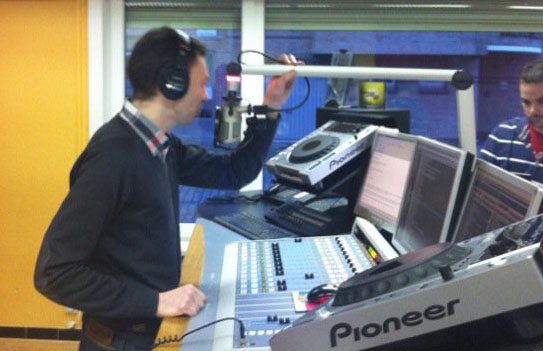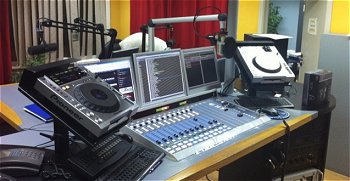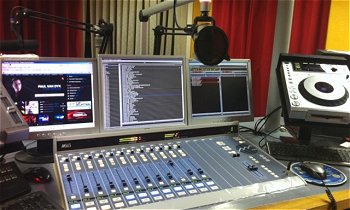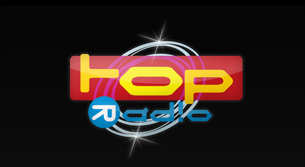SAS Consoles for TOPradio Network in Ghent, Belgium.
Provided by TVV Sound Project bvba
The installation of a brand new SAS on air console marks the upgrade of TOPradio’s broadcast studios to the digital domain and the renewal of the station’s on air work place.
TOPradio was founded in 1996, when three stations in major urban areas in Flanders (Ghent, Bruges and Kortrijk) who worked together as “Dansradio Vlaanderen”, decided to expand their network. Today, TOPradio, with headquarters and studios in Ghent, counts 18 partners throughout Flemish speaking Belgium, offering a hit/dance format. TOP Radio is aiming at the 19-35 age bracket target, and according to the CIM (Centre for Information on the Media), the average TOP listener is 19 years old making it the broadcaster with the youngest audience profile in Flanders. The most recent CIM ratings (published Feb 10th, 2011) put TOPradio in the Flemish top 10 list, with an average daily audience of just over 50.000, leaving competitors like ExQi Fm and the Club FM network behind.
The bulk of TOPradio’s programmes are produced in the Ghent studio’s; a minority of local affiliates produces programme inserts – supplying programme content is the core business of TOPradio. “A first change we made was to get high quality microphones,” commented Bruno Heynderickx, general manager of TOPradio. “We have been testing several brands over the last years and decided that the Neumann BCM103 was really excelling above the rest for our job.”
The new Sierra Automated Systems M-Class console replaced the existing Soundcraft MD1 digital desk; Heynderickx explained that it was TOPradio’s consultant/system integrator TVV Sound to opt for the SAS on air desk. “And I must say we are very happy with that option, and the smooth switch over to the new configuration which took less than one weekend,” he added.
The Souncraft MD1 will get a second life, after revision, in TOPradio’s production studio, where until know engineers worked on an analogue Dateq BCS70 console.
“We decided to invest in the SAS desk because of the high quality audio and reliability - that where the crucial criteria. In addition we have some handy extra’s that come in,” continued Heynderickx. “Apart from the fact that the SAS is fully digital, it allows us to record voice track snippets even when the console is in the on air mode – this is a major timesaver.”
The SAS console is the new core of the on air studio, from which TOPradio produces round-the-clock programmes for the network’s affiliates and the audio stream for telecom provider TeleNet (transmission via the Digibox )
Another extra in de on air studio were two Pioneer DJ Players (DJM800 – it were the DJ’s who specifically asked for them, said Heynderickx. “These CD players are connected via the USB bus and Serato software to the console and go right on the air.”
TOPradio’s specific format and the option to broadcast live radio most of the time reduced the Radio Host play out system to a backup tool. “Between 06.00 hrs and 22.00 hrs, we have live DJ’s on the air, and we use Radio Host as support. In addition to the digital equipment in the studio, we have two Technics 1210MKIII turntables and a dedicated Dateq XTC console so that DJ’s can bring in records themselves, they can adjust the format when they like. So the play out system serves to insert advertising and provides a basic playlist, which may then be adapted throughout the programme.”
One of TOPradio’s popular programmes is the 22.00 – 24.00 hrs bracket where international DJ’s such as Tiësto, Carl Cox, Roger Sanchez and Armin van Buuren give their best records a spin, live on the air and exclusively for TOP Radio.
The station employs some 15 DJ’s to produce the 24/7 programme – between midnight and six am, the music programme is presented by means of voice tracks.
From the Ghent studios, the signal to the 18 affiliates is transmitted via analogue radiolink on the 1.5 Ghz band as allocated by the Belgian communications institute BIPT. “The TOP-
radio network has grown organically,” explained Heynderickx. “And most individual stations had their own transmitters and antenna before signing up with us. Most of them use CTE or DB Elettronica transmitters.
The first reactions of both radio staffers, partner stations and audience were very positive on the radio’s broadcast quality – the Pioneer DJ sets were highly appeciated by the DJ’s.

On-Air Studio


